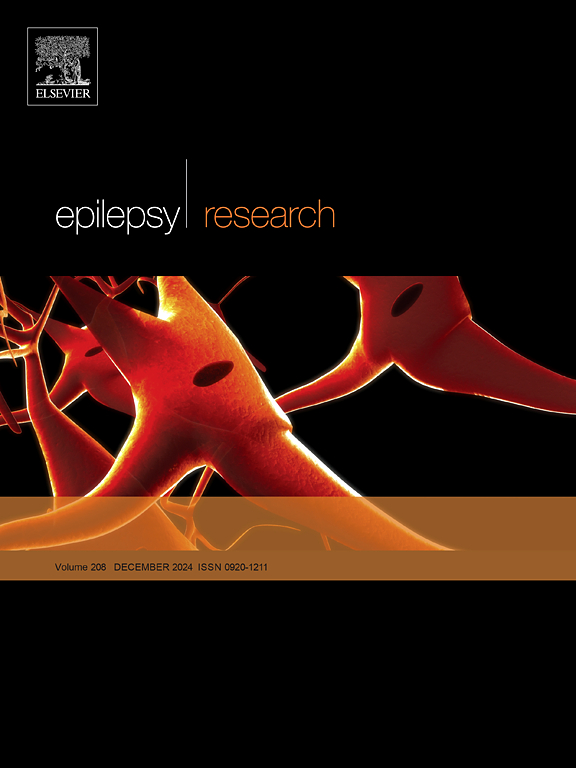Early-phase EEG power spectrum analysis may differentiate acute encephalopathy with biphasic seizures and late reduced diffusion from prolonged febrile seizures
IF 2
4区 医学
Q3 CLINICAL NEUROLOGY
引用次数: 0
Abstract
Background
Acute encephalopathy with biphasic seizures and late reduced diffusion (AESD) is clinically characterized by biphasic seizures associated with mild to severe neurological sequelae and is the most common subtype of acute encephalopathy in Japan, accounting for around 30 % of cases. The present study retrospectively analyzed the utility of electroencephalography (EEG) in determining the optimal method of diagnosing AESD at the early stage.
Methods
This study explores early power value differences to differentiate acute encephalopathy from prolonged febrile seizure (FS). The subjects were patients aged six months to four years who had received intensive care for febrile status epilepticus and had a continuous EEG record up to 24 h after seizure onset. Power spectrum analysis of consecutive, 30-minute recordings at two-hour intervals were conducted, and the power values (alpha, beta, delta, theta waves) were compared between AESD group and FS group.
Results
Eight patients with AESD and 69 patients with FS were identified retrospectively. The emergence of delta waves in the frontal region was significantly higher in the AESD group at six to ten hours after onset. The emergence of beta waves across all the regions was lower in the AESD group from six hours after seizure onset.
Conclusions
Frequency analysis of EEG in the early period after febrile status epilepticus onset demonstrated a significant difference between the AESD and FS groups. Delta wave power values in the frontal region at six to ten hours after onset might be useful for the early differentiation of AESD from FS.
早期脑电图功率谱分析可以区分急性脑病与双相发作和晚期弥散减少从延长的热性发作。
背景:急性脑病伴两期癫痫发作和晚期弥散减少(AESD)的临床特征是两期癫痫发作伴轻度至重度神经系统后遗症,是日本最常见的急性脑病亚型,约占30% %的病例。本研究回顾性分析了脑电图(EEG)在确定早期诊断AESD的最佳方法中的应用。方法:探讨早期功率值差异对急性脑病与延长性热性惊厥(FS)的鉴别价值。研究对象为6个月至4岁的患者,他们因发热性癫痫持续状态接受了重症监护,并在癫痫发作后24 h有连续的脑电图记录。每隔2小时对连续30分钟的记录进行功率谱分析,比较AESD组和FS组的功率值(alpha、beta、delta、theta波)。结果:回顾性分析8例AESD和69例FS。在发病后6至10小时,AESD组额区出现的δ波明显更高。在癫痫发作后6小时,AESD组所有区域的β波出现都较低。结论:热性癫痫持续状态发作后早期脑电图频率分析显示,AESD组与FS组存在显著差异。发病后6至10小时额区δ波功率值可能有助于早期区分AESD和FS。
本文章由计算机程序翻译,如有差异,请以英文原文为准。
求助全文
约1分钟内获得全文
求助全文
来源期刊

Epilepsy Research
医学-临床神经学
CiteScore
0.10
自引率
4.50%
发文量
143
审稿时长
62 days
期刊介绍:
Epilepsy Research provides for publication of high quality articles in both basic and clinical epilepsy research, with a special emphasis on translational research that ultimately relates to epilepsy as a human condition. The journal is intended to provide a forum for reporting the best and most rigorous epilepsy research from all disciplines ranging from biophysics and molecular biology to epidemiological and psychosocial research. As such the journal will publish original papers relevant to epilepsy from any scientific discipline and also studies of a multidisciplinary nature. Clinical and experimental research papers adopting fresh conceptual approaches to the study of epilepsy and its treatment are encouraged. The overriding criteria for publication are novelty, significant clinical or experimental relevance, and interest to a multidisciplinary audience in the broad arena of epilepsy. Review articles focused on any topic of epilepsy research will also be considered, but only if they present an exceptionally clear synthesis of current knowledge and future directions of a research area, based on a critical assessment of the available data or on hypotheses that are likely to stimulate more critical thinking and further advances in an area of epilepsy research.
 求助内容:
求助内容: 应助结果提醒方式:
应助结果提醒方式:


